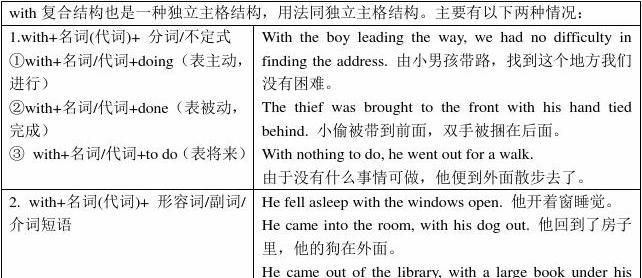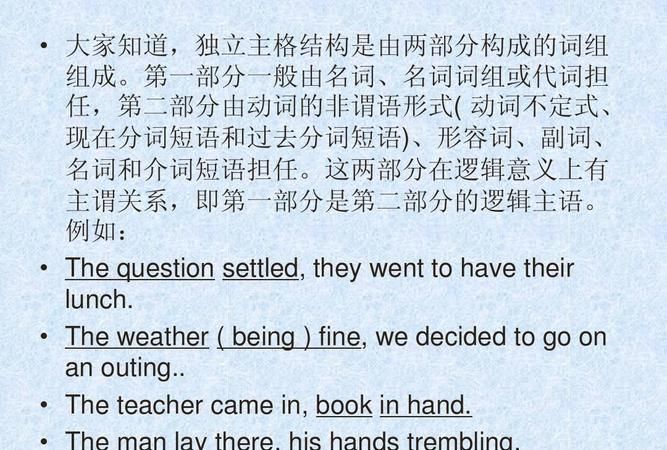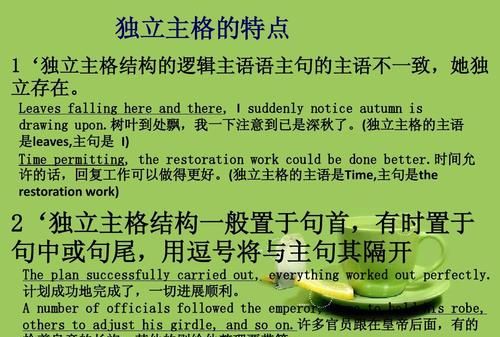本文目录
独立主格的用法总结
独立主格:
简单说一下:
知道代词三个格吧?非谓语动词有三种?
for/of + 宾格 + to -v:不定式复合结构,也就是不定式有自己的逻辑主语;
所有格+动名词:动名词的复合结构,也就是动名词有自己的逻辑主语;
主格+分词: 也就是分词的复合结构。(通常做状语)(当然这个独立主格结构有点类似于复合宾语,除了分词外,还有不定式、形容词、副词、介词短语也可以代替分词使用的)
Weather permitting(条件状语=If weather permits), I will go.
He came in, book in hand(伴随状语=and a book was in his hand)
“with + 宾 + 宾补” 也被认为是独立主格结构。这个结构做状语,也可以做定语。

独立主格结构作状语的用法及举例
独立主格结构由两部分组成,前一部分是名词或者代词,后一部分是非谓语动词(不定式、动名词和分词)或形容词、副词、名词或介词短语。前后两部分具有逻辑主谓关系。
独立主格结构在句中做状语,多用于书面语。 独立主格结构本身不是句子,在句子中作状语,表示时间、原因、条件、伴随、目的等。
用法:
用作时间状语
The work done(=After the work had been done), we went home. 工作完成后,我们就回家了。
用作条件状语
Weather permitting(=If weather permits), they will go on an outing to the beach tomorrow. 如果天气允许的话,他们将在明天组织一次海滨小游。
用作原因状语
An important lecture to be given tomorrow(=As an important lecture will be given tomorrow), the professor has to stay up late into the night. 因为明天要发表一个重要的演讲,教授不得不熬夜到很晚。
用作伴随状语
He was lying on the grass,his hands crossed under his head(=and his hands were crossed under his head).他躺在草地上,将两手交叉枕在脑后。
表示补充说明
We redoubled our efforts,each man working like two. 我们加倍努力,一个人干两个人的活。
*注:独立主格结构表示时间、条件或原因时,相当于一个状语从句,一般放在句首,表示原因时还可放在句末;表伴随状况或补充说明时,相当于一个并列句,通常放于句末。
类型:
1、一般独立主格形式
与主句逻辑关系松散
形式为: n. + -ed/-ing形式; n. +不定式; n. +介词短语; n. +形容词; n. +副词;
名词/主格代词+现在分词
2、名词/主格代词与现在分词之间是主动关系。
如:
The girl staring at him(= As the girl stared at him), he didn't know what to say. 姑娘两眼望着他,他不知道说什么好。
Time permitting(= If time permits), we will go for an outing tomorrow. 如果时间允许的话,我们明天去郊游。
3、名词/主格代词+过去分词
名词/主格代词与过去分词之间是被动关系。
如:
The problems solved(= As the problems were solved), the quality has been improved. 随着问题的解决,质量已经提高了。
Her glasses broken(= Because her glasses were broken), she couldn't see the words on the blackboard. 由于眼镜摔坏了,她看不见黑板上的字。
4、名词/主格代词+不定式
名词/主格代词与不定式之间是主动关系,且强调的是一次具体性的动作。
如:
He is going to make a model plane,some old parts to help. 借助于一些旧零件,他要做一个飞机模型。
They said good-bye to each other,one to go home, the other to go to the bookstore. 他们道别后,一个回了家,一个去了书店。
5、名词/主格代词+形容词
如:
An air accident happened to the plane,nobody alive. 那架飞机遭遇了空难,无一人生还。
So many people absent, the meeting had to be called off. 这么多人缺席,会议不得不取消。
6、名词/主格代词+副词
如:
He put on his sweater ,wrong side out. 他把毛衣穿反了。
The meeting over, they all went home. 会议一结束,他们就都回家了。
7、名词/主格代词+介词短语
如:
The boy goes to the classroom,book in hand. 那男孩手里拿着书去教室。
Mary was sitting near the fire,her back towards the door.玛丽靠近火炉坐着,背对着门。
8、名词/主格代词+名词
His first shot failure,he fired again.
他第一枪没击中,又打了一枪。
Two hundred people died in the accident, many of them children.
两百人死于事故,其中有许多儿童。
9、- with 引导的独立主格:与主句逻辑关系紧密
形式为: with + n. + -ed/-ing形式; with + n. +adj.; with +n. +介词短语
with ( without)+宾语(名词/代词)+宾语补足语,宾语通常由名词或代词充当,但代词一定要用宾格。上文的独立主格结构的几种情况都适用于此结构。
如:
The girl hid her box without anyone knowing where it was.
小女孩把盒子藏了起来,没有人知道它在哪里。(without +名词/代词+动词的-ing形式)
Without a word more spoken, she left the meeting room.
她没再说什么话就离开了会议室。(without+名词/代词+动词的-ed形式)
The kid feels excited with so many places of interest to visit.
有这么多的名胜可参观,小孩很激动。(with+名词/代词+动词不定式)
The boy was walking, with his father ahead.
父亲在前,小孩在后走着。(with+名词/代词+副词)
He stood at the door, with a computer in his hand. 或He stood at the door, computer in hand.
他站在门口,手里拿着一部电脑。(with+名词/代词+介词短语)
With his son so disappointing, the old man felt unhappy.
由于儿子如此令人失望,老人感到很不快乐。(with+名词/代词+形容词)
在with (without) 的复合结构中,多数情况下with 能省略,但without 不能省略。
10、- each引导的强调型独立主格:
形式为:句子 +复数名词结尾 , each +介词短语/形容词短语/名词短语/-ing形式/-ed形式
这种独立主格结构为了强调句尾的复数名词
如:
Under the restructuring, the huge organization that operates the company's basic businesses will be divided into five groups,each with its own executive.(题源:《GMAT语法全解》白勇著,Page38)
11、-There being +名词(代词)
There being nothing else to do, we went home. 没有别的事可做,我们就回家了。
There being no further business, I declare the meeting closed. 没有再要讨论的事了,我宣布散会。
12、-It being +名词(代词)
It being Christmas, the government offices were closed. 由于圣诞节的缘故,政府机关都休息。
It being a holiday, all the shops were shut. 由于今天是假日,所有商店都关门了。

with的独立主格结构用法
独立主格结构由两部分组成,前一部份是名词或者代词,后一部分是非谓语动词(不定式、动名词和分词)或形容词、副词、或介词短语。前后两部分具有逻辑主谓关系。独立主格结构在句中做状语,多用于书面语。
独立主格结构本身不是句子,在句子中作状语,表示时间、原因、条件、伴随、目的等。
1、 伴随状语(方式状语):相当于一个并列句。
He was watching TV, his mouth half open.
He fell to the ground, blood coming down his nose.
The policeman entered the dark room,gun in hand.
The old man sat down,his face pale with pain.
2、 时间状语:相当于一个时间状语从句。
Meeting over, everyone tried to do something for the project.
Spring coming, the flowers are coming out.
The problem settled, everyone was filled with joy.
3、 原因状语:相当于一个原因状语从句。
John (being) away, Tom had to do the work on his own.
It being dark, they had to walk with the torches on.
There being no bus, they had no choice but to take a taxi.
4、 条件状语:相当于一个条件状语从句。
Weather permitting, we’ll have a picnic this Sunday.
Enough time given, we’ll do the job better.
注:有时可以在独立主格前面加上介词with,构成with +复合宾语结构。
如:With the problem settled, the computer restarted.
With the old man leading, we had no difficulty finding the old Red Army man’s house.
You should not speak to others with your mouth full of food.
He left the bathroom,with the water running.
He rushed out with a knife in his hand. 此句可改写为 He rushed out ,a knife in his hand.或 He rushed out, knife in hand.
但是,“with + 复合宾语”结构也可以用作定语。
如:Soon they found themselves walking in a valley with high mountains aroud it.
He lives in a village with a railway behind it.
Harry Potter is a boy with a scar on his forehead.

独立主格的用法总结思维导图
一般独立主格形式:与主句逻辑关系松散形式为:n.+-ed/-ing形式;n.+不定式;n.+介词短语;n.+形词;n.+副词。独立主格结构有两部分组成,前一部份是名词或者代词,后一部分是非谓语动词(不定式、动名词和分词)或形词、副词、或介词短语。
前后两部分具有逻辑主谓关系。独立主格结构在句中做状语,多用于书面语。独立主格结构本身不是句子,在句子中作状语,表示时间、原因、条件、伴随、目的等。
“独立结构”在句中起状语作用,相当于状语从句,表示时间、原因、条件、方式或伴随等情况。

以上就是关于独立主格及其用法 ,独立主格的用法总结的全部内容,以及独立主格及其用法 的相关内容,希望能够帮到您。

